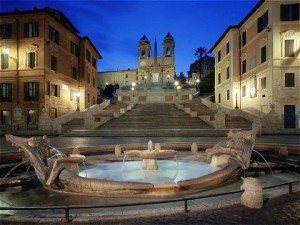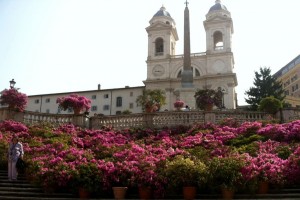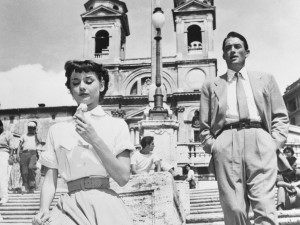 Spanish Steps – Thousands of sightseers visit Italy’s capital city every day. Tourists from around the world flock to the Eternal City because of the many attractions and monuments.
Spanish Steps – Thousands of sightseers visit Italy’s capital city every day. Tourists from around the world flock to the Eternal City because of the many attractions and monuments.
Piazza di Spagna, or Spanish Square, has a triangular irregular structure and is connected to the late Renaissance French titular church of La Trinité-des-Monts (Trinità dei Monti) and to the Pincian Hill by a long staircase descending from the hill, which is known as the Spanish Steps (Scalinata di Spagna or Scalinata della Trinità dei Monti). This is the widest staircase in Europe and you can enjoy a really awesome view from the top.
 Piazza di Spagna is one of the most popular meeting spots in the city of Rome. It attracts both locals and tourists and is almost always crowded. The set of 138 steps is divided by three landings, which are banked with azalea plants in spring. The architecture of the staircase is superbly lost beneath a gorgeous array of color.
Piazza di Spagna is one of the most popular meeting spots in the city of Rome. It attracts both locals and tourists and is almost always crowded. The set of 138 steps is divided by three landings, which are banked with azalea plants in spring. The architecture of the staircase is superbly lost beneath a gorgeous array of color.
Piazza di Spagna also features a fountain, called Fountain of the Old Boat (Fontana della Barcaccia), designed by Pietro Bernini and his son Gian Lorenzo for Pope Urban VIII to commemorate the flooding of the Tiber River in year 1598. The fountain was built in the shape of a boat stranded at that place once the waters receded. In Spanish Square there is also the Column of the Immaculate Conception (Colonna dell’Immacolata), a column created to commemorate the immaculate conception.
For centuries, the Spanish Steps, Piazza di Spagna and its adjacent area have welcomed travelers, dukes and writers in search of inspiration, including personalities of the likes of Stendhal, Lord Byron RS and William Makepeace Thackeray.
The Spanish Steps and Spanish Square get their names from the Spanish Embassy to the Vatican on the square, although the staircase was actually built with French funds in the 18th century. over the years, this site has grown into a distinctive landmark in Italy’s capital city, not to mention one of the most celebrated urban monuments of Baroque style, attracting tourists, visitors, sightseers and locals all year round. More than a few other tourist attractions, including churches, museums and Baroque monuments, are a close walk away and worth a visit too.
Note that the rose scam has increased in this area in recent years. A man comes up with a rose and insists he wants to give it to you for free, but then demand money to you or your partner. Just keep walking and say no assertively several times. That is not dangerous, but can be annoying. Pickpockets are very active in this area too. Do not leave your bag open while you take pictures.
 Piazza di Spagna and the Spanish Steps in media
Piazza di Spagna and the Spanish Steps in media
This staircase is shown up in a number of movies, including 1953 film Roman Holiday, starring Gregory Peck and Audrey Hepburn, where she enjoys her ice-cream, and The Talented Mr. Ripley, where Tom Ripley, played by Matt Damon, arranges for Marge Sherwood and Peter Smith-Kingsley, played by Gwyneth Paltrow and Jack Davenport respectively, to meet. Roman Holiday made the Spanish Steps famous to an American audience.
Spanish Steps at night
Spanish Steps, Pincio view & Campo de Fiori at sunset is a new walk tour in Rome.
Experience the famous Dolce Vita of Rome on a 3-hour walking tour and see its historic piazzas at magical sunset hour, when the city truly comes alive.
Start at the lovely Piazza del Popolo, built in the 16th century beside the old parish church of Santa Maria del Popolo. The oval-shaped piazza has undergone many modifications over the centuries, but maintains its glorious aspect.
Continue to the Pincio (Pincian Hill), one of the fabled 7 hills of Rome, where you will find the Neo-classical landscaped garden by Giuseppe Valadier. The gardens feature broad sidewalks of pine trees, palms, and evergreen shrubs, and offer a fantastic view over Piazza del Popolo.
Continue to Piazza di Spagna (Spanish Steps) to climb the monumental stairway that curves gracefully up to the Church of SS. Trinita’ del Monti. Next, walk to the Piazza di Trevi to throw a coin in the Trevi Fountain. According to legend, those that do will one day return to Rome. Continue to the Piazza della Rotonda to marvel at the miraculously well preserved Pantheon, built in 27 BC.
Stroll over to the Piazza della Rotonda to marvel at the miraculously well preserved Pantheon, built in 27 BC as a temple to all the gods. Move on to Rome’s most famous square for “La Dolce Vita.” Piazza Navona was built on the site of an ancient arena, and retains the form of the stadium once used for animal fights and gladiatorial combats.
End at the Campo de’ Fiori, northwest of the Capitol. The former meadow was never architecturally formalized, instead developing as a center of commerce, with streets leading off it named after the various trades, such as milliners, tailors, and crossbow makers.
Discover the walk tour Piazza di Spagna, Pincio view & Campo de Fiori at night
How to get to Spanish Steps
A good restaurant in Rome?
http://www.italy2love.com/restaurant-cafe-da-claudia-pantheon-rome/
